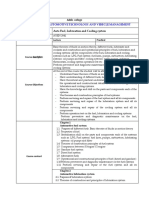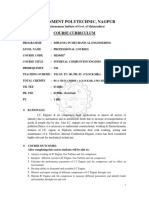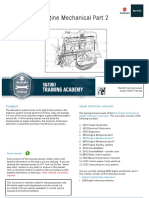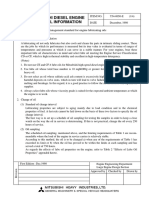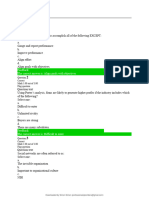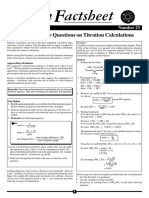F&L 3330204
F&L 3330204
Uploaded by
zack knightCopyright:
Available Formats
F&L 3330204
F&L 3330204
Uploaded by
zack knightOriginal Description:
Copyright
Available Formats
Share this document
Did you find this document useful?
Is this content inappropriate?
Copyright:
Available Formats
F&L 3330204
F&L 3330204
Uploaded by
zack knightCopyright:
Available Formats
Fuels and Lubricants Course code: 3330204
GUJARAT TECHNOLOGICAL UNIVERSITY, AHMEDABAD, GUJARAT
Course Curriculum
FUELS & LUBRICANTS
(Code: 3330204)
Diploma Programme in which this course is offered Semester in which offered
Automobile Engineering 3rd Semester
1. RATIONALE
Fuels are the energy sources for any vehicle and lubricants are used to reduce energy
losses due to friction. Both are available in very wide range but only some of them
have found their application in vehicle because of their some desirable properties.
Their use not only affects the engine performance and vehicle life but also affect the
environment. Due to different chemical composition different fuels behave differently
during combustion process. Also their end products are different for different
combination of parameters, like pressure, temperature, air etc. To justify the selection
of proper fuel and lubricants for particular vehicle and particular assembly students of
automobile engineering must have knowledge of fuels and lubricants. This course
enables students of automobile engineering to understand the fuels and lubricants with
reference to vehicle performance.
2. COMPETENCIES: (Programme Outcomes (POs) According to NBA
terminology)
The course content should be taught and with the aim to develop different types of skills
so that students are able to acquire following competency:
Select proper fuel and lubricant depending upon application for better
performance and maintenance of automobiles.
3. TEACHING AND EXAMINATION SCHEME
Teaching Scheme Total Credits Examination Scheme
(In Hours) (L+T+P) Total
Theory Marks Practical Marks
Marks
L T P C ESE PA ESE PA
3 0 2 5 70 30 20 30 150
Legends: L - Lecture; T - Tutorial/Teacher Guided Student Activity; P - Practical; C - Credit; ESE - End
Semester Examination; PA - Progressive Assessment
GTU/NITTTR/Bhopal/12-13 Gujarat State
1
Fuels and Lubricants Course code: 3330204
4. COURSE DETAILS
Major Learning Outcomes Topics and Sub-topics
(Course Outcomes in
Unit
Cognitive Domain according
to NBA terminology)
Unit – I 1a. Describe the term fuels its 1.1 Basic requirements of a fuel & lubricant.
Introduction to types & uses 1.2 Types of fuels & lubricants its uses &
Fuels 1b. Describe the term sources
lubricants its types & 1.3 Theory of origin and accumulation of crude
uses. oil
1c. Explain the origin and 1.4 Methods of searching crude oil
manufacturing of fuel & 1.5 Recovery of crude oil
lubricants. 1.6 Classification of crude oil
1.7 Classification of hydrocarbon
1.8 Structure of various hydrocarbon
1.9 Fractional distillation and classification of
refinery products
1.10 Various refining processes
1.11 Blending and treatment of gasoline
Unit – II 2a. Explain the properties of 2.1 Various desirable properties of SI engine
Properties and fuels and their effect on fuels
Additives of Fuel engine performance 2.2 Their effect on engine performance
2b. Explain the various 2.3 Additives of gasoline
additives used to enhance 2.4 Various desirable properties of CI engine
performance of fuels fuels
2.5 Their effect on engine performance
2.6 Additives of diesel
Unit – III 3a. Describe the phenomenon 3.1 Combustion in SI engine
Combustion of combustion in SI and 3.11 (i) Normal and abnormal combustion
Process and CI engine 3.12 (ii) Factors affecting normal
Rating of Fuels 3b. Appreciate the combustion
terminologies involved in 3.13 (iii)Ignition Lag and factors affecting
combustion and their it
effect 3.14 (iv) Pre-ignition and its effects
3c. Explain the qualities of 3.15 (v) Detonation, its effects and factors
fuels affecting it and prevention
3.2 Combustion in CI engine
3.21 (i) Phases of combustion in CI engine
3.22 (ii) Factors affecting combustion in
CI engine
3.23 (iii)Ignition Lag and factors affecting
it
3.24 (iv) Diesel knock, its effects and
factors affecting it and prevention
3.3 Rating of Fuel
3.31 (i) Octane number, merits and
demerits of higher octane fuel and
normal octane fuel
3.32 (ii) Cetane number
Unit – IV 4a. Explain various frictional 4.1 Engine frictional losses
losses 4.2 Factors affecting frictional losses
Introduction to 4b. Explain the phenomenon 4.3 Boundary lubrication
Engine Friction of lubricant 4.4 Hydro dynamic lubrication
and Lubricants 4c. Describe the importance 4.5 Classification and types of lubricanting oil
GTU/NITTTR/Bhopal/12-13 Gujarat State
2
Fuels and Lubricants Course code: 3330204
Major Learning Outcomes Topics and Sub-topics
(Course Outcomes in
Unit
Cognitive Domain according
to NBA terminology)
of lubricant and types of (based on crude oil, synthetic oil)
lubricants 4.6 Basic requirements of lubricants
4d. Describe the 4.7 Distillation process to get lubricating oil
manufacturing of from crude oil
lubricants 4.8 Various treatment given to the lubricating
4e. Explain the term grease oil
4.9 Types of grease and its characteristics
Unit – V 5a. Explain various properties 5.1 various properties of lubricating oil
Properties, of lubricating oil 5.2 Gradation of lubricating oil
Gradation and 5b. Describe gradation of 5.3 Introduction of ISO Cleanliness code.
Additives of lubricating oil 5.4 Function and type of additives of
Lubricants 5c. Explain requirement of lubricating oil
additives
Unit- VI 6a. Describe alternative fuels 6.1. Alternative fuels and their economics-like,
Alternative Fuel Alcohol, Ethanol, Methanol, Hydrogen,
LPG, CNG, Bio Gas, Bio diesel
Unit-VII 7a. Describe various 7.1 Measurement of various properties of fuels
Measurement of instruments used for & lubricants.
Various measuring various
Properties of properties of fuels & 7.2 Safety precautions while measuring
Fuels & Lubricant lubricants. properties of fuels & lubricants.
7b. Describe the experimental
procedures.
5. SUGGESTED SPECIFICATION TABLE WITH HOURS & MARKS (THEORY)
Unit Unit Title Distribution of Theory Marks
Teaching R U A Total
Hours Level Level Level Marks
I Introduction to Fuels 7 7 7 0 14
II Properties and Additives 7 3 4 0 7
of Fuel
III Combustion Process and 6 0 7 7 14
Rating of Fuels
IV Introduction to Engine 6 3 7 4 14
Friction and Lubricants
V Properties, Gradation and 6 3 4 0 7
Additives of Lubricants
VI Alternative Fuel 6 0 3 4 7
VII Measurement of Various 4 3 4 0 7
Properties of Fuels &
Lubricant
Total 42 19 36 15 70
Legends: R = Remember; U = Understand; A = Apply and above levels (Bloom’s revised taxonomy)
GTU/NITTTR/Bhopal/12-13 Gujarat State
3
Fuels and Lubricants Course code: 3330204
Note: This specification table shall be treated as a general guideline for students and teachers.
The actual distribution of marks in the question paper may vary slightly from above table.
6. SUGGESTED LIST OF PRACTICAL/EXERCISES
The practical/exercises should be properly designed and implemented with an attempt to develop
different types of practical skills (Course Outcomes in psychomotor and affective domain) so that
students are able to acquire the competencies (Programme Outcomes). Following is the list of
practical exercises for guidance.
Note: Here only Course Outcomes in psychomotor domain are listed as practical/exercises.
However, if these practical/exercises are completed appropriately, they would also lead to
development of Programme Outcomes/Course Outcomes in affective domain as given in a common
list at the beginning of curriculum document for this programme. Faculty should refer to that
common list and should ensure that students also acquire those Programme Outcomes/Course
Outcomes related to affective domain.
Sr. UnitNo. Practical Exercise(Any Seven) (Course Outcomes in Apprx.
No. Cognitive Domain according to NBA terminology) Hrs.
Required
1 I Draw the chart & Describe distillation process of crude 4
oil.
2 II Determination of viscosity of given sample of fuel 4
using u-tube viscometer..
3 V Determination of viscosity of lubricating oil at different 4
temperature.
4 II Determination of flash and fire point of given sample 4
of fuel.
5 II Determination of specific gravity of given sample of 4
fuel by westphal Balance
6 V Determination of carbon residue of lubricating oil 4
7 III Study of CFR engine and knock meter. 4
8 II Study of measuring API gravity of fuel. 4
9 V Determination of cloud and pour point of given sample 4
of oil.
Total 28
GTU/NITTTR/Bhopal/12-13 Gujarat State
4
Fuels and Lubricants Course code: 3330204
7. SUGGESTED LIST OF STUDENT ACTIVITIES
a. Internet based assignment related to crude oil and refinery work.
b. Visit of fuel station and collect data about instrument they used to check the
properties of fuel and norms and precautions they are following
c. Internet based assignment/literature survey for types of lubricants with their
specific use
d. Market survey to find out the specification of different types and brands of fules
and lubricants and their relative cost
e. Internet based assignment to check the use of alternative fuels along with
advantages of using them and problem encountered by using them
8. SPECIAL INSTRUCTIONAL STRATEGIES (If Any)
a. Visit to a fuel station
b. Use of animation or video clips
c. Chart (such as combustion phenomenon of SI and CI engine, distillation process)
9. SUGGESTED LEARNING RESOURCES
A. List of Books
S.No. Author Title of Books Publication
1 V.M. Internal combustion Dhanpat Rai Publishing Company (P)
Domkundwar engines Ltd
2 K. M. Gupta Automobile Engineering Umesh Publication
3 C.P.Nakra, Basic Automobile Engg. Dhanpat Rai Publishing Company (P)
Ltd
4 M.Popovich and Fuels and Lubricants John Wiley & Sons, Inc
Haring
5 R.L.Bechtold Alternative Fuels SAE Publication.
Guidebook
6 R. K. Rajput Internal Combustion Laxmi Publication
Engine
B. List of Major Equipment/ Instrument
a. Red wood viscometer
b. Flash and fire point apparatus
c. Fuel distillation plant
d. Cloud and pour point apparatus
e. Carbon residue tester
f. CFR test engine
g. U tube viscometer
h. Westphal balance
GTU/NITTTR/Bhopal/12-13 Gujarat State
5
Fuels and Lubricants Course code: 3330204
C. List of Software/Learning Websites
1. http://www.youtube.com/watch?v=_hwzJUDWIQQ
2. http://www.youtube.com/watch?v=vscX_zawdQw
3. http://www.youtube.com/watch?v=Nd_pybvuIgc
4. http://www.youtube.com/watch?v=Cg9El12wMlU
5. http://www.youtube.com/watch?v=RSBs7PRo-fA
6. http://www.youtube.com/watch?v=9Py8-Xy9MKo
7. http://www.youtube.com/watch?v=NXYESrwhcPY
8. http://www.youtube.com/watch?v=h7GVHPEfpU4
9. http://www.youtube.com/watch?v=Gs3gfwG9a7k
10. http://www.youtube.com/watch?v=vundAm8q9Rw
11. http://www.youtube.com/watch?v=OIr-D-tIPyo
12. http://www.youtube.com/watch?v=agtYALodDcg
13. http://www.youtube.com/watch?v=suce6QNkVRI
14. http://www.youtube.com/watch?v=3Ql342fTH7A
15. http://www.youtube.com/watch?v=Qns7eXe4B4c
16. http://www.youtube.com/watch?v=R0g4RYMdAsI
17. http://www.youtube.com/watch?v=hk7NvgmvwnM
18. http://www2.tech.purdue.edu/at/courses/at403/Lubrication_systems.ppt
19. http://lubricantspecialist.files.wordpress.com/2011/10/basic-of-lubricants-
lubrication.ppt
20. http://mustafaozcanli.com/wp-content/uploads/2012/05/FAL_1.ppt
10. COURSE CURRICULUM DEVELOPMENT COMMITTEE
Faculty Members from Polytechnics
Prof. M. J. Pathak, Head Automobile Engineering Department, Sir Bhavsinhji
Polytechnic Inst., Bhavnagar.
Prof. A. C. Suthar, Lecturer, Automobile Engineering Department, M.L. Institute of
Diploma Studies, Bhandu
Prof. D. J. Gohel, Lecturer, Automobile Engineering Department, C.U. Shah
Polytechnic, Surendranagar
Coordinator and Faculty Members from NITTTR Bhopal
Dr. C. K. Chugh, Professor, Department of Electronic Media
Dr. (Mrs.) Vandana Somkuwar, Associate Professor, Department of Mechanical
Engineering.
GTU/NITTTR/Bhopal/12-13 Gujarat State
6
You might also like
- OCR GCSE 9-1 Business, Third EditionDocument329 pagesOCR GCSE 9-1 Business, Third EditionAnya Johal86% (14)
- ES9-224 Lubricating Oil Rev WDocument13 pagesES9-224 Lubricating Oil Rev WIfran Sierra100% (1)
- Course Title:: Petroleum Refining & Petrochemical Technology Course Code: 3350503Document7 pagesCourse Title:: Petroleum Refining & Petrochemical Technology Course Code: 3350503Viraj Patel100% (1)
- Petroleum and PetrochemicalDocument7 pagesPetroleum and PetrochemicalAbhishek GondNo ratings yet
- 3330201Document7 pages3330201DEADPOOL 2No ratings yet
- Automobile Engine Diagnosis and TestingDocument7 pagesAutomobile Engine Diagnosis and TestingwolerosNo ratings yet
- 4-Fuels and Pollution Control-20at44pDocument9 pages4-Fuels and Pollution Control-20at44pMD HUZAIFA HANDURNo ratings yet
- A060631 - 00E FuelsDocument39 pagesA060631 - 00E Fuelslawternay stevaneli de britoNo ratings yet
- Automotive Fuels and Lubrication LabDocument2 pagesAutomotive Fuels and Lubrication LabHari KrishNo ratings yet
- Course ObjectivesDocument5 pagesCourse ObjectivesHyjan JacobNo ratings yet
- Enhanced Energy Efficiency in Industrial LubricationDocument125 pagesEnhanced Energy Efficiency in Industrial Lubricationmanoj gupta guptaNo ratings yet
- Group - 2Document3 pagesGroup - 2richyawsNo ratings yet
- Textbook: Package P3: Kiln - Operation and Optimisation Fuel Types and Their CharacteristicsDocument35 pagesTextbook: Package P3: Kiln - Operation and Optimisation Fuel Types and Their CharacteristicsSantanu PachhalNo ratings yet
- Hints For 4.4Document2 pagesHints For 4.4Malik Junaid100% (1)
- Department of Automotive Technology and Vehicle ManagementDocument2 pagesDepartment of Automotive Technology and Vehicle ManagementmulualemNo ratings yet
- FPCS AssignmentDocument2 pagesFPCS Assignmentk4kapadia1110No ratings yet
- AE PracticalDocument4 pagesAE Practicaljasmin k. rachhadiyaNo ratings yet
- Used Oil Vs Unused OilDocument5 pagesUsed Oil Vs Unused OilREZANo ratings yet
- Study On Fuel Injection SystemDocument47 pagesStudy On Fuel Injection SystemSaeed BarzegarNo ratings yet
- Study On Fuel Injection SystemDocument47 pagesStudy On Fuel Injection SystemLudwig HernandezNo ratings yet
- Government Polytechnic, Nagpur: Course CurriculumDocument8 pagesGovernment Polytechnic, Nagpur: Course CurriculumAyush LolusareNo ratings yet
- Afe All PDFDocument10 pagesAfe All PDFjigar patelNo ratings yet
- Course ObjectivesDocument4 pagesCourse ObjectivesHyjanJacobNo ratings yet
- Apltcl029 SGD L-01Document91 pagesApltcl029 SGD L-01Cukke CokNo ratings yet
- Me 232 Thermal Engineering LaboratoryDocument9 pagesMe 232 Thermal Engineering Laboratorym.waseemNo ratings yet
- Krishna FR DDocument6 pagesKrishna FR Dsafal shaNo ratings yet
- ContentsDocument7 pagesContentsRushikesh RohamareNo ratings yet
- First Semester 2021-2022 Course Handout Part IIDocument2 pagesFirst Semester 2021-2022 Course Handout Part IIshreyNo ratings yet
- Subject Inroduction 3171923 Lecture-1Document11 pagesSubject Inroduction 3171923 Lecture-1freee9044No ratings yet
- Summer 2014 Model Answer PaperDocument16 pagesSummer 2014 Model Answer PaperadityaNo ratings yet
- Calculo de Volumen in SituDocument62 pagesCalculo de Volumen in SituJulio Ramirez SuarezNo ratings yet
- Auto MechanicsDocument6 pagesAuto MechanicsdrrebaNo ratings yet
- ijcpe, عمل اسعد سالم وتحسين حميد3Document7 pagesijcpe, عمل اسعد سالم وتحسين حميد3Igor Celso CelsoNo ratings yet
- 12 PDFDocument108 pages12 PDFAreef Ahamad ShaikNo ratings yet
- Engine Fundamentals - Lubrication y Mas J20B PDFDocument109 pagesEngine Fundamentals - Lubrication y Mas J20B PDFAlejandro Muñoz PatiñoNo ratings yet
- Ic Enginecombustion & PollutionDocument6 pagesIc Enginecombustion & PollutionsajithukNo ratings yet
- Ice Course PlanDocument8 pagesIce Course PlanmallikarjunbpatilNo ratings yet
- Apex ManualDocument70 pagesApex ManualSudhir SainiNo ratings yet
- A001072 01eDocument97 pagesA001072 01eNutthakarn WisatsiriNo ratings yet
- 94-Article Text-200-1-10-20200623Document9 pages94-Article Text-200-1-10-20200623Annisa PujiatiNo ratings yet
- Lecture_plan_170780006022989292365caf5fccc64dDocument2 pagesLecture_plan_170780006022989292365caf5fccc64dbilaljhon753No ratings yet
- ICEDocument5 pagesICEArihant ShijuNo ratings yet
- Course Title: Fuels & Combustion Course Code: 5053 Course Category: E Periods/Week: 4 Periods/Semester: 60 Credits: 4Document3 pagesCourse Title: Fuels & Combustion Course Code: 5053 Course Category: E Periods/Week: 4 Periods/Semester: 60 Credits: 4vaisakmctNo ratings yet
- Gujarat Technological University: W.E.F. AY 2018-19Document3 pagesGujarat Technological University: W.E.F. AY 2018-19AkashNo ratings yet
- TurbochargerDocument95 pagesTurbochargerCurtler PaquibotNo ratings yet
- Correct LubricantDocument69 pagesCorrect LubricantZeshan Haydar100% (1)
- B.E. 8th Sem ELE - III-Adv. IC EngineDocument3 pagesB.E. 8th Sem ELE - III-Adv. IC EngineSantosh AloneNo ratings yet
- IC Course Guide BookDocument5 pagesIC Course Guide BookAddisu AyeleNo ratings yet
- FT InformationDocument374 pagesFT InformationUmesh DeshNo ratings yet
- Mitsubishi Diesel Engine Technical Information: Management Standard For Engine Lubricating OilsDocument4 pagesMitsubishi Diesel Engine Technical Information: Management Standard For Engine Lubricating OilsMoniru islamNo ratings yet
- Instant ebooks textbook Lubricants Introduction to Properties and Performance 1st Edition Marika Torbacke download all chaptersDocument50 pagesInstant ebooks textbook Lubricants Introduction to Properties and Performance 1st Edition Marika Torbacke download all chapterscouribekki1q100% (2)
- Elaine SkeneDocument106 pagesElaine SkeneMeghana Crasta100% (1)
- 14713Document57 pages14713quillaseohNo ratings yet
- Study On Durability of Engine & Engine Oil in Presence of ContaminantsDocument14 pagesStudy On Durability of Engine & Engine Oil in Presence of ContaminantsAnandNo ratings yet
- IC Engines and Reciprocating Machines COURSE Guide BookDocument6 pagesIC Engines and Reciprocating Machines COURSE Guide BookEphrem AbabiyaNo ratings yet
- Tribology TransactionsDocument9 pagesTribology TransactionsAli RobikaNo ratings yet
- Science Talks: Mekala Manikanta, D.R. SrinivasanDocument7 pagesScience Talks: Mekala Manikanta, D.R. SrinivasanNatán Pérez SánchezNo ratings yet
- Elective I Elective II: University of Mumbai, Mechanical Engineering (Third and Final Year) Revised Course (Rev-2012)Document2 pagesElective I Elective II: University of Mumbai, Mechanical Engineering (Third and Final Year) Revised Course (Rev-2012)navneetkpatil8409No ratings yet
- Robin HoodDocument36 pagesRobin HoodTaz UddinNo ratings yet
- Machinery Oil Analysis & Condition Monitoring : A Practical Guide to Sampling and Analyzing Oil to Improve Equipment ReliabilityFrom EverandMachinery Oil Analysis & Condition Monitoring : A Practical Guide to Sampling and Analyzing Oil to Improve Equipment ReliabilityRating: 3.5 out of 5 stars3.5/5 (5)
- Functionalism Exchange and Theoretical Strategy Michael MulkayDocument84 pagesFunctionalism Exchange and Theoretical Strategy Michael Mulkaymedeiaseveri24No ratings yet
- Our World and Our People B1 B3 1Document77 pagesOur World and Our People B1 B3 1dansokelvin815No ratings yet
- Michelle Orner: 402 Cabin Hollow Road Dillsburg, PA 17019-9607 Cell: (717) 329-4706Document2 pagesMichelle Orner: 402 Cabin Hollow Road Dillsburg, PA 17019-9607 Cell: (717) 329-4706mlo5037No ratings yet
- LOM OTH AmbergDocument2 pagesLOM OTH AmbergChaudary Azhar Saleem0% (1)
- Examen Parcial Ingles General IVDocument11 pagesExamen Parcial Ingles General IVOscar Bernrdo RodriguezNo ratings yet
- GRADED QUIZZES UNIT 6 REVISION Bus 1101Document89 pagesGRADED QUIZZES UNIT 6 REVISION Bus 1101lubuto1976No ratings yet
- Curriculum Research "Reading": ObjectivesDocument28 pagesCurriculum Research "Reading": ObjectivesGRose SolisNo ratings yet
- D H A W (. 3000 BCE - 700 CE) : 6th Version, March 2019Document71 pagesD H A W (. 3000 BCE - 700 CE) : 6th Version, March 2019Achmad Roghib UbaidillahNo ratings yet
- Bark and Wood Boring Insects in Living Trees in Europe, A SynthesisDocument581 pagesBark and Wood Boring Insects in Living Trees in Europe, A SynthesisIonut MarianNo ratings yet
- 10 The Adventure Academy PF2eDocument17 pages10 The Adventure Academy PF2eSimon Bergeron100% (2)
- Lesson Plan in Tle 9Document4 pagesLesson Plan in Tle 9Herbert Shirov Tendido Securata100% (1)
- CH 2 Cornell NotesDocument5 pagesCH 2 Cornell NotesRMHSMarconiNo ratings yet
- Chapter 6 Personal LetterDocument7 pagesChapter 6 Personal LetterDewi UmbarNo ratings yet
- The Educators-Summary of Radio 4 Series: Sir Ken Robinson-Schools Are A Barrier To Creativity, As He Has Argued OnDocument5 pagesThe Educators-Summary of Radio 4 Series: Sir Ken Robinson-Schools Are A Barrier To Creativity, As He Has Argued OnJDMcDougallNo ratings yet
- Insights Test Series For Prelims - 2015: Detailed Schedule For Test - 14 To 33Document6 pagesInsights Test Series For Prelims - 2015: Detailed Schedule For Test - 14 To 33Durgeshinsights InsightsNo ratings yet
- Fakultas Keguruan Dan Ilmu Pendidikan Unversitas Muhammadiyah TangerangDocument3 pagesFakultas Keguruan Dan Ilmu Pendidikan Unversitas Muhammadiyah TangerangFitraNo ratings yet
- Module 1 Methods of ResearchDocument27 pagesModule 1 Methods of ResearchKenneth Ramos PasamonteNo ratings yet
- Conflict TheoryDocument23 pagesConflict TheoryLKC GuicoNo ratings yet
- Geology Thesis Proposal ExampleDocument5 pagesGeology Thesis Proposal Examplepamelawilliamserie100% (1)
- Research - TeamATeam (FINAL) PDFDocument42 pagesResearch - TeamATeam (FINAL) PDFykye.ysobelNo ratings yet
- Course Syllabus: E Niversity OF THE Hilippines IsayasDocument4 pagesCourse Syllabus: E Niversity OF THE Hilippines IsayasKempetsNo ratings yet
- Agency Profile - Crisis Text LineDocument4 pagesAgency Profile - Crisis Text Lineapi-454123714No ratings yet
- Myth LPDocument4 pagesMyth LPFlorens Genoves BagatNo ratings yet
- Prefix SuffixDocument8 pagesPrefix SuffixKiran R RaneNo ratings yet
- Modern Grey ResumeDocument2 pagesModern Grey ResumeTricia SegundoNo ratings yet
- III Bba CA - Internship Report GuidelinesDocument19 pagesIII Bba CA - Internship Report GuidelinesnikithaNo ratings yet
- 23titra PDFDocument2 pages23titra PDFThuvarakaNo ratings yet
- Department of Education, Culture and Sports vs. San DiegoDocument3 pagesDepartment of Education, Culture and Sports vs. San DiegoZafra ChunNo ratings yet
- Chopra Health Enrichment Program Syllabus: Course OverviewDocument3 pagesChopra Health Enrichment Program Syllabus: Course OverviewAndra MariaNo ratings yet














